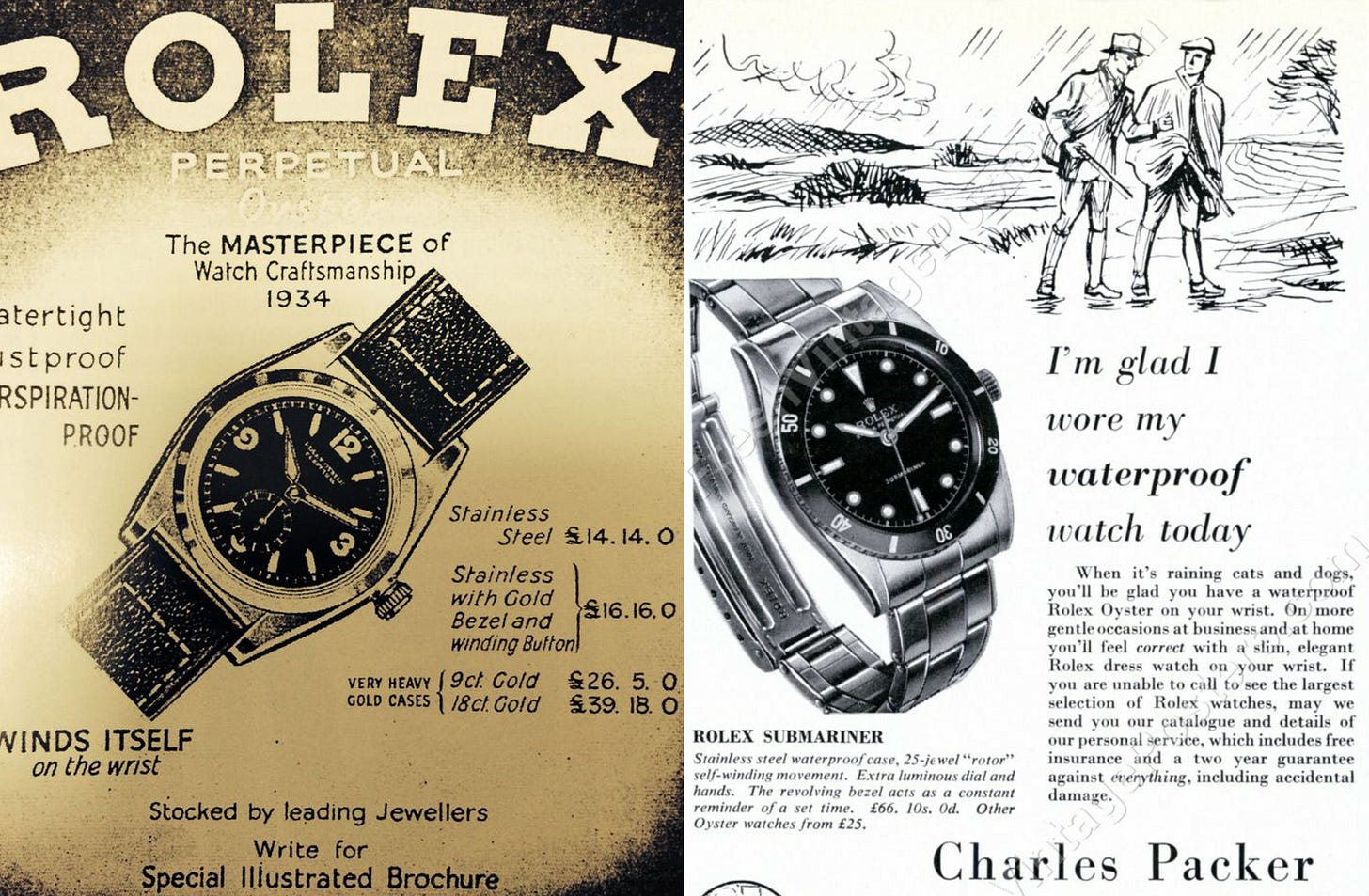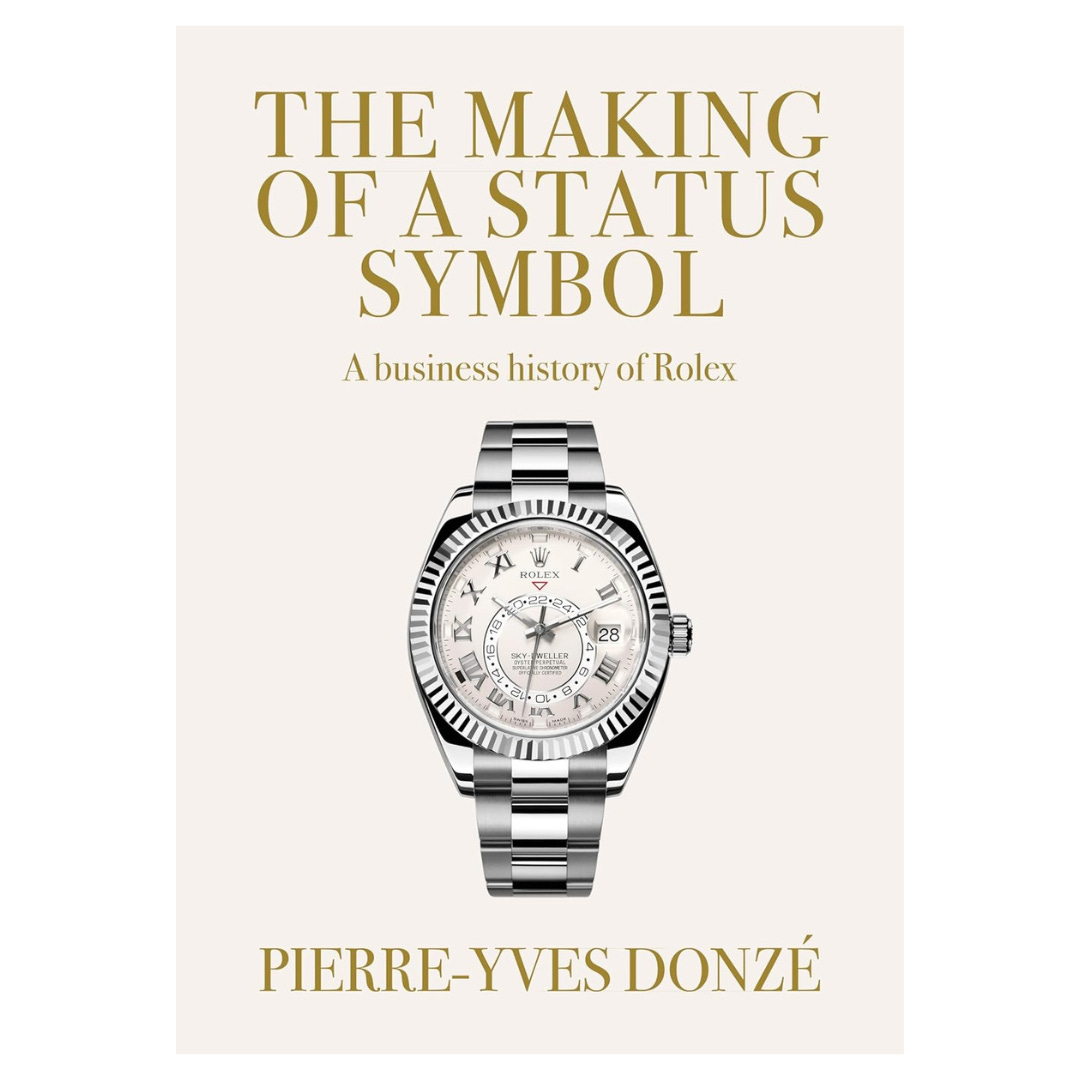Behind the Crown: What ‘Status Symbol’ Reveals (And Doesn’t) About Rolex
The first serious history of Rolex shows us what we’ve missed—and what we’re still not allowed to see; plus, Parmigiani isn't getting sold after all.
I went to a vintage market in Chicago last weekend. A few vendors popped up at a wine bar on a Sunday afternoon—vintage clothes, old furniture, design objects. My buddy Joey was there selling some watches—nothing crazy, mostly quirky old Seikos.
But people loved it. These markets have grown a ton lately. Maybe it’s just a millennial gloss on the flea market—but who cares?

I was thinking about this while texting a friend who lives on the German side of Switzerland, where retailer Les Ambassadeurs has made noise for offering 30% discounts after saying its brand partners wouldn’t buy back slow-moving stock.
He took advantage, picking up a Blancpain Ultraplate, a watch he’d liked for years but “neither [1] wanted to pay the full ridiculous retail price, nor [2] deal with the hassle and general unpleasantness of the grey market.” Getting it for a third off didn’t feel like a steal—“just the right price.”
It gets to the core issues for the primary and secondary markets:
Primary market prices feel inflated
The grey market can be confusing or even intimidating, especially for new buyers.
I wonder what will happen faster: (1) the grey market becomes increasingly professional, or (2) the primary market adjusts? I’d bet on the former—it’s already happening with more brand-backed CPO programs.
More broadly, it’s part of a current cultural shift toward vintage and secondhand—watches, clothes, furniture, even kitchenware. But as this weekend reminded me, the joy in buying pre-owned often is feeling like you found a deal. I hope we don’t lose that flea-market fun along the way.
In today’s newsletter: Parmigiani Fleurier and its suppliers aren’t getting sold after all, and an exploded watch that I want for my desk. But today’s main event is all about Rolex—
🍻 Windup Kick-Off Event: I co-organized an event with Studio Underd0g, Atelier Wen, and Formex on Friday, July 11, after the first day of Windup Watch Fair in Chicago. It’s in West Loop, just a mile from Windup. If you’re around, come hang—full details and RSVP here.
Behind the Crown: What ‘Status Symbol’ Reveals (And Doesn’t) About Rolex
[Brendan Cunningham, PhD is a professor of economics who brings this perspective to his writing about watches. I’ve known him for a long time (we even published a paper together once), so I’m excited to bring his take of an important new book on the history of Rolex to Unpolished.—Tony]
By: Brendan Cunningham, PhD
Exploring the history of Rolex is like studying black holes: No light escapes. So researchers, like astronomers, examine what happens around it. Rolex has a well-earned reputation for secrecy—very little information escapes.
This was clear after reading the recently released English language edition of Pierre-Yves Donze’s, The Making of a Status Symbol: A Business History of Rolex ($30; Amazon), which presents a rich history of what’s happened around Rolex.
Donze, a well-known business professor, begins with Rolex's infant years and moves through the modern era. Readers benefit from his ability to access original materials in French and German without translation, and his extensive experience in watchmaking business history. Donze presents one of the broadest bodies of translated information, drawn, in part, from Rolex-related primary source materials, made clear by his 607 footnotes.
Donze draws a few conclusions:
He highlights the role of advertising agencies that pivoted Rolex away from technical product characteristics in advertising. Instead, in the 1960s and 1970s, advertising began to focus on the accomplishments of people who wear Rolex—in politics, sports, and adventure. (I present similar evidence in my book.) This transformed Rolex from a brand built on performance to one built on aspiration.
He claims that product innovation largely slowed when Andre Heiniger took over as Rolex CEO in 1962. I was less convinced by this argument—we’ll get to that.
Perhaps the strongest material in Donze's work is a collection of time-series graphs plotting trends in various outcomes, such as watch prices, patents, and chronometer certificates. As an economist, I love a good graph. This material alone is reason enough to read Donze’s book. But it also illustrates the central tension in my experience with it.

For example, let’s consider a figure that shows a count of “Patents filed by Rolex, 1889-2019.” Donze states that almost half of all patents obtained by Rolex since the end of the 19th century were obtained between 1990 and 2019 (page 213). After a lull in patents through the 1960s and ‘70s, we see an explosion through the modern era. His central thesis, a shift to positioning its watches as totems of individual achievement, doesn’t fully explain this more recent growth in patents.
It extends beyond a single graph. In another instance, he suggests that by attributing Rolex’s historic military sales to North America, it becomes one of the largest markets. But this suggestion wouldn’t make sense: Rolex and Tudor have supplied militaries across the world.
A ‘Fervent Admirer’?
This context gives us a different lens through which we can interpret Donze’s headline-grabbing endnote regarding Rolex founder Hans Wilsdorf’s World War II sympathies. Donze presents the following quote, which was originally written by police in Geneva (emphasis mine):
“‘The information gathered shows that Wilsdorf is a fervent admirer of the Hitler regime.’”
I felt an obligation to chase down the source materials, eventually obtaining the original French from the Swiss Federal Archives:
Des renseignements recueillis il ressort que WILSDORF est un fervent admirateur du régime Hitlérien. Il ne se cache pas pour manifester sa satisfaction lorsque des événements favorables à l'Allemagne se produisent. Nous n'avons par contre pas remarqué ni appris qu'il fasse de la propagande pro-hitlérienne ou qu 'il ait une activité suspecte.
What’s translated as “show” more literally translates to “it emerges that”—not idiomatic English, but an important nuance that’s less definitive. Moreover, additional archival materials attached to this allegation cast more doubt.
The British set the Swiss upon the path of asking questions about Wilsdorf’s allegiance. But two allegations made by the British are dubious according to archival materials:
The Swiss could not confirm a British allegation about Wilsdorf’s brother;
A second British allegation that the Swiss Federal Aliens Police kept a file on Wilsdorf also proved false.
These kinds of subtleties should be presented so readers can make their own judgments. My sense is that Wilsdorf probably grappled with neutrality just as much as the rest of Switzerland during the War. After all, the stories of Rolex offering watches to Allied troops are also well known.
After this revelation last year, the Hans Wilsdorf Foundation, the non-profit owner of Rolex, promised an investigation into the claims, which is ongoing.
The Collector Perspective

Donze’s thesis is that Rolex’s success is due to its transition from focusing on the technical aspects of its watches to marketing them, in the title’s terms, as the ultimate “status symbol.”
He claims that product innovation slowed in the ‘60s. But, from the innovative Sea-Dweller and its helium release valve (released in 1967) to the new Dynapulse escapement in this year’s Land-Dweller, Rolex continues to create innovative products and its watches are praised across the board today.1
This is not to mention its aesthetic “innovations”: The Genta-designed Midas, stone dial Day-Dates and Datejusts, and “off-catalog,” flashy gemset watches. The design focus may prove Donze’s point, but the technical know-how remains.
As other brands have adopted similar marketing strategies, Rolex has remained in a class of its own (estimates put its annual turnover at 3x its closest competitors). Readers may be left wondering how Rolex’s blend of product innovation and marketing focus made this so.

My recommendation: Donze’s Status Symbol is a serious piece of research and scholarship that should be read and appreciated by anyone with an interest in Rolex. But I’d also recommend other books, like Nick Foulkes’ recent Oyster Perpetual Submariner: The Watch that Unlocked the Deep, for which Foulkes was given access to Rolex’s archives.
These and others are each a piece of the puzzle that helps you form your own perspective on the most important watch brand in the world.
Brendan Cunningham, PhD, is a professor of economics and writer. He’s the author of Selling the Crown: The Secret History of Marketing Rolex. You can also find his writing on his blog, Horolonomics.
Classifieds
Welcome to the Unpolished Classifieds. It’s a place to promote cool things to our 10k+ subscribers & watch collectors. Promote your event, sale, newsletter, app, book, tools, or accessories. No watch brand ads. Price: $500 for four ads. Max. 300 characters per ad. Drop a line if you’re interested: tony[at]unpolishedwatches.com.
🎉 Minutes + Hours Los Angeles
Explore over 60 brands and thousands of watches at the Minutes + Hours Show in Los Angeles, July 26–27. See, try and buy microbrands, indies & more. Get your free tickets now:
Parmigiani Fleurier Isn’t Getting Sold After All

After more than a year of rumors (and really more than that), the Sandoz Family Foundation says it’s holding onto its watch division, which includes Parmigiani Fleuer and its suppliers, notably movement manufacturer Vaucher Fleurier.
There were rumors that Hermés, LVMH, and even the Meylan family (which owns H. Moser and Hautlence) might be interested in an acquisition. LVMH wanted Sandoz’s manufacturing capabilities, but now seems committed to using Zenith instead (it probably doesn’t help that LVMH stock is down ~30% this year).




